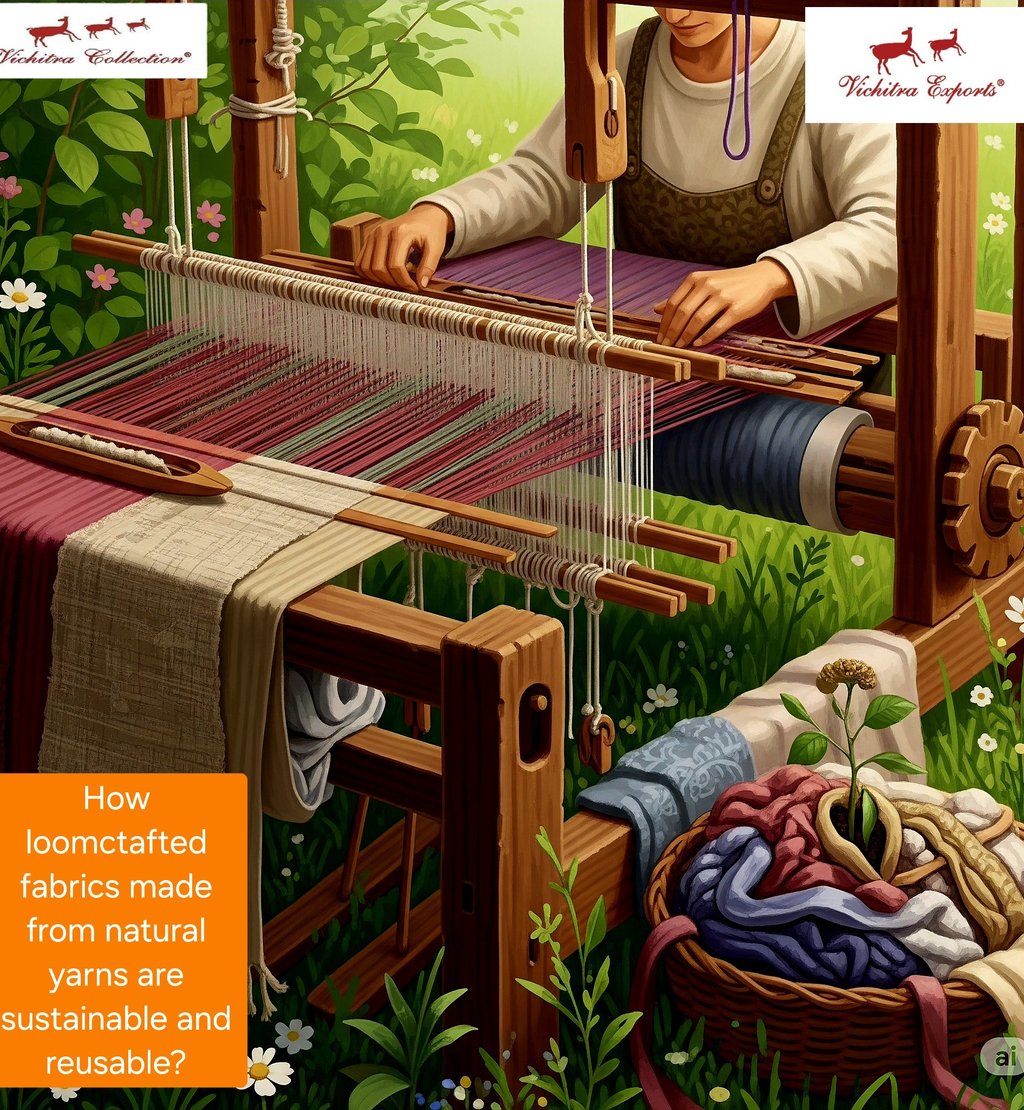How Loom crafted fabrics are sustainable
Blog post description.
HANDLOOM FABRICSHAND BLOCK PRINTED FABRICSCOTTON FABRICSSILK FABRICS


#The Sustainable Elegance of Loom-Crafted Fabrics at Vichitra Exports
In today's world, where environmental concerns are at the forefront of our minds, the textiles we choose play a pivotal role in determining our ecological footprint.
At Vichitra Exports, contributing in society on creating stunning, loom-crafted fabrics from natural yarns that are not only visually captivating but also sustainable and reusable. This blog explores how our weaving practices lead to reduced waste and promote a more responsible approach to fashion.
#The Art of Loom Weaving
Loom weaving is a traditional craft that has been practiced for centuries. It combines skill, creativity, and a deep respect for nature. The process of weaving fabrics from natural yarns involves weaving threads together to create unique patterns and textures. At Vichitra Exports, our skilled artisans utilize
time-honored techniques that honour this tradition while integrating modern sensibilities to produce fabrics that are both functional and beautiful.
#Natural Yarns: A Sustainable Choice The cornerstone of our fabrics’ sustainability lies in the use of natural yarns. Unlike synthetic fibers, which are often derived from petroleum-based products and can take centuries to decompose, natural yarns are biodegradable and come from renewable sources. We use materials such as cotton, wool, linen, and silk, prioritizing and responsibly sourced fibres to minimize the environmental impact. Using natural yarns not only ensures a lower carbon footprint but also supports sustainable agriculture. By partnering with local farmers who practice eco-friendly farming methods, we ensure that our materials are produced with minimal harm to the environment. This holistic approach allows us to produce fabrics that are not just beautiful but also environmentally responsible.
#Reducing Waste Through Thoughtful Production One of the most significant environmental advantages of loom-crafted fabrics is the reduced waste involved in their production. At Vichitra Exports, we employ a careful and deliberate weaving process that maximizes material use and minimizes off-cuts. Here’s how we achieve this:
1. **Efficient Material Usage**: Our weaving techniques are designed to maximize the use of yarn during production. Each piece is meticulously crafted to ensure that we minimize leftover materials, which not only saves resources but also reduces waste.
2. **Upcycling and Recycling**: Any leftover ends from the weaving process are thoughtfully repurposed into other products, including smaller fabric items like bags, pouches, or home décor. This upcycling approach aids in creating a circular economy within our production processes.
3. **Timeless Design**: The unique beauty of loom-crafted fabrics lies in their timeless designs. By focusing on styles that transcend trends, we encourage consumers to invest in pieces that they will cherish for years. Durable fabrics not only maintain their quality over time but also reduce the need for frequent replacements, thereby lessening waste generation.
#The Reusability Factor The reusability of loom-crafted fabrics goes hand-in-hand with their sustainable nature. Each piece of fabric produced by Vichitra Exports is designed with longevity in mind, supporting consumers in making eco-conscious choices.
Here’s how we ensure the reusability of our fabrics:
1. Production: Our skilled weavers pay close attention to the quality and construction of each piece. By using high-quality natural yarns and implementing precise weaving techniques, we deliver fabrics that are robust, long-lasting, and able to withstand wear and tear.
2. Versatile Applications: The versatility of our fabrics means they can be used for various applications—from home textiles such as curtains and cushions to fashion items like scarves and dresses. This multi-functionality encourages consumers to explore multiple uses for each piece, further extending the life of the fabric.
3. Easy Care and Maintenance: Our loom-crafted fabrics are not only aesthetically pleasing but are also easy to care for. Natural fibers typically have low environmental impacts when washed and dried compared to synthetic materials. They can be washed with natural detergents and do not require the high heat settings that synthetic alternatives often do.
#### The Impact of Sustainable Practices Adopting sustainable practices within the fabric production industry is vital for combating the growing issue of textile waste. The fashion industry is notorious for its high levels of waste, but at Vichitra Exports, we demonstrate that it is possible to produce beautiful textiles without compromising the environment. Our commitment to sustainability is not just a trend; it’s a philosophy that guides every aspect of our production process.
At Vichitra Exports, we believe that by creating fabrics that are sustainable, reusable, and require less waste, we are contributing to a larger movement towards responsible fashion. We are inspired by the potential of weaving to tell stories, inspiring a connection between nature and craft that resonates with eco-conscious consumers.
#### Conclusion By choosing loom-crafted fabrics made from natural yarns at Vichitra Exports, you are not only enhancing your wardrobe with unique, high-quality textiles but also supporting a sustainable future. Our commitment to minimizing waste and maximizing reusability reflects a growing awareness of the environmental impact of our choices. With each fabric, you are participating in a movement toward responsible consumerism that prioritizes sustainability without sacrificing style. Join us as we weave a greener future—one thread at a time. Embrace the elegance of loom-crafted fabrics that are as kind to the planet as they are to your aesthetic sensibilities. Together, let’s take strides towards a sustainable world, one beautiful fabric at a time.
